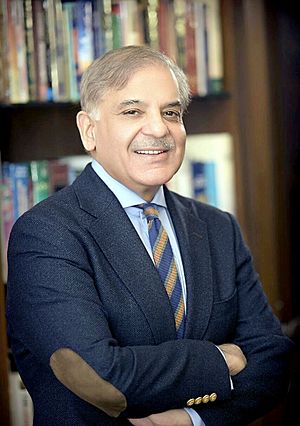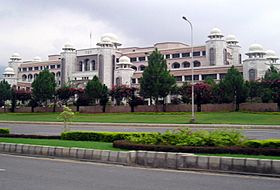Prime Minister of Pakistan facts for kids
Quick facts for kids Prime Minister of Pakistan |
|
|---|---|
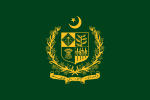
Prime ministerial standard
|
|
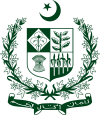
|
|
| Executive branch of the Government of Pakistan |
|
| Style |
|
| Abbreviation | PM |
| Member of |
|
| Reports to | |
| Residence | Prime Minister House |
| Seat | Islamabad |
| Nominator | National Assembly of Pakistan |
| Appointer | President of Pakistan |
| Term length | At the pleasure of the president subject to Article 91(7) of the Constitution. |
| Constituting instrument | Constitution of Pakistan |
| Inaugural holder | Liaquat Ali Khan (1947–1951) |
| Formation | 14 August 1947 |
| Deputy | Deputy Prime Minister of Pakistan |
| Salary | ₨24.12 lakh (US$15,000) , annual |
The prime minister of Pakistan is the head of government for the Islamic Republic of Pakistan. This means they lead the country's government. The prime minister is in charge of the cabinet, which is a group of important government officials. The president of Pakistan is the country's head of state, but the prime minister holds the main executive power.
The prime minister is usually the leader of the political party or group that has the most members in the National Assembly. This is the lower house of Pakistan's federal parliament. The prime minister stays in office as long as they have the support of the National Assembly. They are known as the "chief executive of the Islamic Republic."
Pakistan's prime minister leads the government's executive branch. They manage the country's economy and lead the National Assembly. They also head the Council of Common Interests and the Cabinet. The prime minister is also in charge of the National Command Authority, which oversees Pakistan's nuclear weapons. This role gives the prime minister control over all important matters, both inside Pakistan and in its dealings with other countries.
The prime minister is chosen by the members of the National Assembly. The Constitution of Pakistan gives the prime minister executive powers. This includes choosing the Cabinet and making important government decisions. The prime minister also advises the president on key issues. They play a big role in choosing military leaders and making sure the military is controlled by civilians. The prime minister's powers have grown a lot over time.
The position of prime minister was not active during certain periods. This happened in 1958–1973, 1977–1985, and 1999–2002. During these times, the military took control, and the president held the prime minister's powers.
Contents
History of the Prime Minister's Role
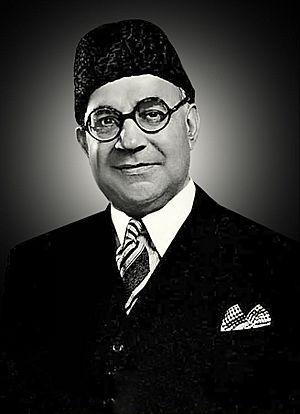
The job of prime minister started when Pakistan became independent in 1947. The first prime minister was Liaquat Ali Khan. He had a lot of power until he was assassinated in 1951. Over time, the power of the prime minister was sometimes reduced. This happened because the governor-general, who represented the British monarchy, often got involved.
In 1956, Pakistan's first Constitution made the country an "Islamic republic." The governor-general's role changed to that of the president of Pakistan. However, between 1951 and 1957, six prime ministers were dismissed by the governor-general or president. In 1958, President Iskandar Mirza dismissed the prime minister and declared martial law. Soon after, army chief General Field Marshal Ayub Khan took over.
In 1962, a new Constitution removed the prime minister's office completely. All power went to the president. But people criticized this system, especially after the 1965 presidential election. The office of prime minister was brought back after the 1970 elections. Nurul Amin became prime minister and also vice-president.
After the war with India in 1971, the presidential system collapsed. The Constitution was fully restored in 1973. This brought back the prime minister's role with more central powers. Pakistan became a parliamentary system, where the president's role was mostly ceremonial. However, in 1977, the military again intervened and suspended the prime minister's post.
The prime minister's role was restored after the 1985 elections. Muhammad Khan Junejo became prime minister. Later that year, a change to the Constitution gave the president the power to dismiss the prime minister. In 1988, Benazir Bhutto became the first woman prime minister in a Muslim country.
From 1988 to 1993, there was a power struggle between the prime minister and the president. The president dismissed the National Assembly three times. In 1997, Nawaz Sharif became prime minister. His party gained a large majority and changed the Constitution. This gave the prime minister more executive powers.
In 1999, General Pervez Musharraf staged a military takeover. He held elections in 2002. A new prime minister, Zafarullah Khan Jamali, was appointed. A new constitutional change partially restored the president's power to dissolve the National Assembly. However, this needed approval from the Supreme Court of Pakistan.
In 2004, Prime Minister Jamali resigned, and Shaukat Aziz became prime minister. In 2008, the Pakistan Peoples Party came to power. They supported removing Pervez Musharraf from office. In 2010, a major change to the Constitution removed the president's power to dissolve Parliament on their own. This made Pakistan a parliamentary democratic republic again.
In 2012, the Supreme Court removed Prime Minister Yousuf Raza Gillani from office. This was due to a legal issue. Raja Pervaiz Ashraf then became prime minister until 2013. In the 2013 elections, Nawaz Sharif was elected prime minister for the third time. This was a democratic transfer of power. In July 2017, Nawaz Sharif was disqualified from office by the Supreme Court. This was due to a legal issue related to his financial declarations.
On August 18, 2018, Imran Khan became Pakistan's 22nd prime minister. On April 10, 2022, he lost a motion of no confidence. This made him the first prime minister in Pakistan to be removed from office this way.
On April 11, 2022, Shehbaz Sharif was elected as the 23rd Prime Minister. He served for two years, completing Imran Khan's term. On March 3, 2024, Shehbaz Sharif was re-elected for his second term as the 24th Prime Minister.
How the Prime Minister Works
The Constitution says that the president of Pakistan is the head of state. The president represents the "unity of the Republic." But the prime minister is the "chief executive of the Republic." This means the prime minister runs the government.
The prime minister is also the head of the Council of Common Interests. This council includes the chief ministers from each province.
In Pakistan's parliamentary system, the prime minister is usually the leader of the party or group that has the most members in the National Assembly. The prime minister, like all other ministers, must be a member of the National Assembly.
Prime Minister's Role and Powers
The prime minister's main workplace is the Prime Minister's Office in Islamabad. The official home, called Prime Minister Enclave, is nearby. The prime minister is the chief executive who leads the Government of Pakistan. After getting enough support from Parliament, the president asks the prime minister to take an oath of office and form the government.
The prime minister chooses the members of the Cabinet. These members oversee important government departments. The prime minister tells the president about all Cabinet decisions and new laws.
The prime minister also attends Parliament sessions and answers questions from members of Parliament. They make many important appointments, including:
- Leaders of government ministries.
- Chief secretaries for the provinces.
- Key military leaders in the Pakistan Armed Forces.
- Heads of large public organizations like PIA.
- Chairmen of federal commissions.
- Ambassadors to other countries.
Some specific government bodies are usually led by the prime minister:
- Planning Commission
- National Command Authority
- National Security Council
The prime minister has control over Pakistan's nuclear weapons. They also represent Pakistan in international meetings and organizations. The prime minister often speaks to the nation about important issues.
Who Can Be Prime Minister?
The Constitution of Pakistan says that the prime minister must be a member of the National Assembly. They must also:
- Be a citizen of Pakistan.
- Be a Muslim.
- Be over 25 years old.
- Show good behavior and follow Islamic teachings.
- Have good knowledge of Islam and practice its duties.
- Not have worked against Pakistan's unity or its founding ideas since the country was created.
How a Prime Minister is Chosen and Removed
Candidates for prime minister are members of the National Assembly. They are chosen by people voting in elections. Usually, the leader of the party with the most members in Parliament becomes prime minister. This person forms the government. The candidate must get enough support from Parliament members before the president asks them to form the government.
A prime minister can be removed from office before their term ends. This happens if Parliament passes a vote of no confidence. If a majority of the National Assembly votes against the prime minister, they lose their job. In the past, presidents could dismiss prime ministers, but this power was removed in 2010.
The prime minister has special protection from legal actions while in office. No criminal or civil cases can be started against them during their term.
In 2012, the Supreme Court of Pakistan removed one prime minister from office. This was because of a legal issue. On July 28, 2017, the Supreme Court also disqualified Prime Minister Nawaz Sharif. This was due to a legal issue related to his financial declarations.
The National Assembly elects the prime minister. This happens on the 21st day after a general election, which occurs at least every five years. The person chosen serves as prime minister until the next election or until they lose the support of the National Assembly.
91. The Cabinet:
(1) There shall be a Cabinet of Ministers, with the Prime Minister at its head, to aid and advise the President in the exercise of his functions.
(2) The National Assembly shall meet on the twenty-first day following the day on which a general election to the Assembly is held unless sooner summoned by the President.
(3) After the election of the Speaker and the Deputy Speaker, the National Assembly shall, to the exclusion of any other business, proceed to elect without debate one of its Muslim members to be the Prime Minister.
(4) The Prime Minister shall be elected by the votes of the majority of the total membership of the National Assembly:
Provided that, if no member secures such majority in the first poll, a second poll shall be held between the members who secure the two highest numbers of votes in the first poll and the member who secures a majority of votes of the members present and voting shall be declared to have been elected as Prime Minister:
Provided further that, if the number of votes secured by two or more members securing the highest number of votes is equal, further poll shall be held between them until one of them secures a majority of votes of the members present and voting.
(5) The member elected under clause (4) shall be called upon by the President to assume the office of Prime Minister and he shall, before entering upon the office, make before the President oath in the form set out in the Third Schedule:
Provided that there shall be no restriction on the number of terms for the office of the Prime Minister.
Taking the Oath of Office
Before starting their job, the prime minister must take an oath in front of the president. In this oath, they promise to protect and defend the Constitution. They also promise to serve Pakistan honestly and always in the country's best interest.
I, ____________, do swear solemnly that l am a Muslim and believe in the Unity and Oneness of Almighty Allah, the Books of Allah, the Holy Qura'an being the last of them, the Prophethood of Muhammad (peace be upon him) as the last of the Prophets and that there can be no Prophet after him, the Day of Judgment, and all the requirements and teachings of the Holy Quran and Sunnah:
That I will bear true faith and allegiance to Pakistan:
That, as Prime Minister of Pakistan, I will discharge my duties, and perform my functions, honestly, to the best of my ability, faithfully in accordance with the Constitution of the Islamic Republic of Pakistan and the law, and always in the interest of the sovereignty, integrity, solidarity, well- being and prosperity of Pakistan:
That I will strive to preserve the Islamic Ideology which is the basis for the creation of Pakistan:
That I will not allow my personal interest to influence my official conduct or my official decisions:
That I will preserve, protect and defend the Constitution of the Islamic Republic of Pakistan:
That, in all circumstances, I will do right to all manner of people, according to law, without fear or favor, affection or ill- will:
And that I will not directly or indirectly communicate or reveal to any person any matter which shall be brought under my consideration or shall become known to me as Prime Minister except as may be required for the due discharge of my duties as Prime Minister.
May Allah Almighty help and guide me (A'meen).
See also
 In Spanish: Primer ministro de Pakistán para niños
In Spanish: Primer ministro de Pakistán para niños
- Principal Secretary to the Prime Minister of Pakistan
- Deputy Prime Minister of Pakistan
- List of prime ministers of Pakistan
- Prime Minister House, Pakistan


